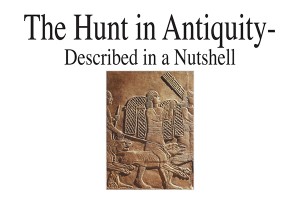The Hunt in Antiquity – Described in a Nutshell
Click here to read the complete article
 text and illustrations by Ria Hörter
text and illustrations by Ria Hörter
Antiquity has nothing to do with Stone Age Neanderthals in early Europe. The history and culture of Mesopotamia, Egypt, Greece, and Rome – ca. 3000 BC to the fall of the Roman Empire in 476 – is generally identified as antiquity, a remarkable period that left us abundant information about hunters and hunting.
From around 3000 BC, the Sumerians in Mesopotamia (now Iraq) hunted gazelle, wild boar, stags, wild mules and birds, not for pleasure but to supplement their grain and other crops. We know the Sumerians principally as the inventors of cuneiform script – a hallmark in the development of writing to record events, stories and laws. A gold Sumerian bowl dating from 3000 BC, in the collection of the Louvre in Paris, shows a dog hunting in the swamps near Babylon, but not much is known about the way the Sumerians hunted.
Assyrians in Mesopotamia from 2000 BC have become well known for their bas-relief sculptures showing military campaigns, hunting and the king. World-famous is the relief of Assyrian hunters and their hunting mastiffs, dating from 645-635 BC, on the palace walls of Nineveh, a city on the Tigris River.
This relief has become famous, not only because it’s a splendid piece of art and history, but as well because it is an early depiction of lion hunting with mastiffs.
Some historians think that King Ashurbanipal himself (668-627 BC) is depicted on the relief. Assyrian rulers were known for their great passion for hunting lions, elephants, stags and gazelles. Falconry was popular between the rivers Euphrates and Tigris.
For Assyrians, the hunt had a political and religious significance. If the king was a successful hunter, the gods were well-disposed toward him. The hunt was part of their legitimacy and held in high regard. Assyrians worshipped Ninurta, an ancient Mesopotamian god associated with farming, healing, hunting, law and war. The Egyptians, Greeks, and Romans likewise had gods of hunting: Egyptians worshipped Neith and Anhur; Artemis was the Greek goddess of the hunt and Diana was her Roman counterpart. The vast plains in Mesopotamia were ideal hunting grounds, especially for lions. In formalized ritual hunts in an arena, lions in wooden cages were released and driven by men with short, thick sticks toward the king standing in a chariot. The king could kill the lions quite easily using a spear or bow and arrow.
Click here to read the complete article
Short URL: http://caninechronicle.com/?p=181433
Comments are closed












